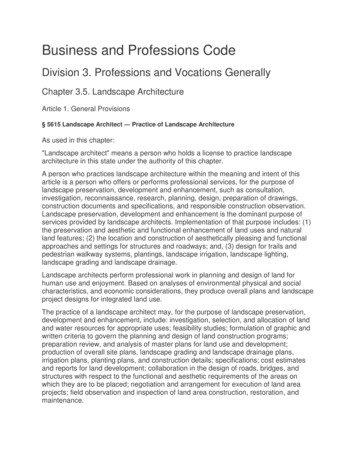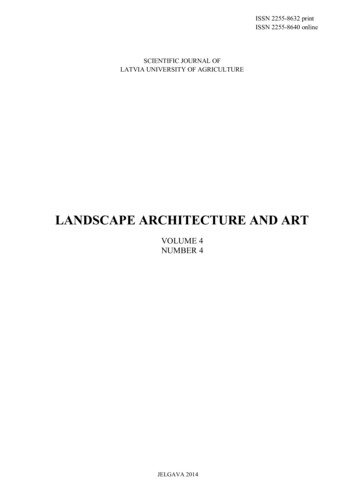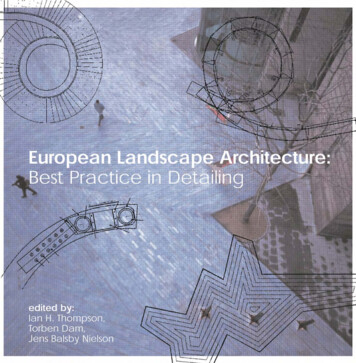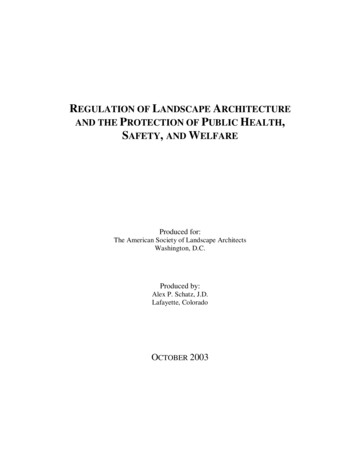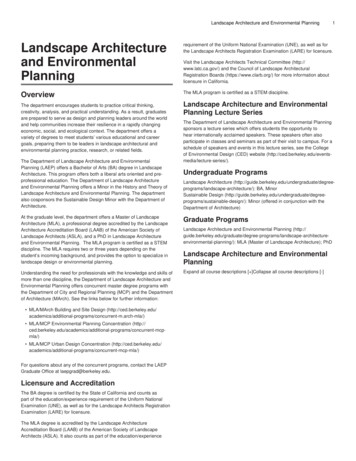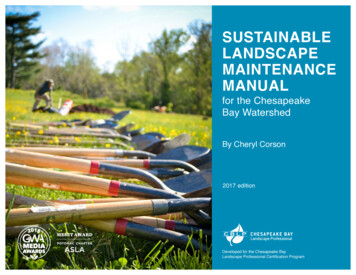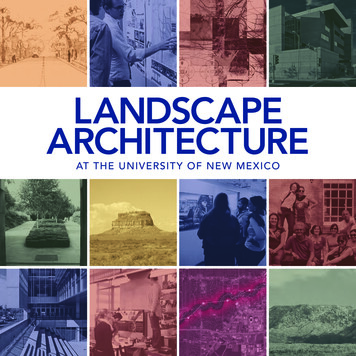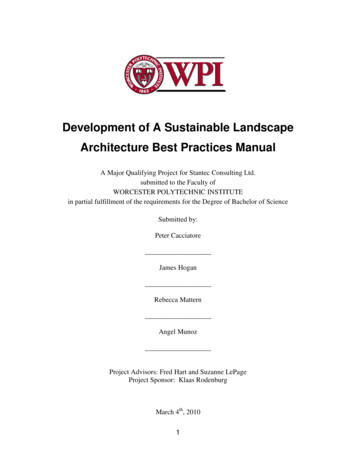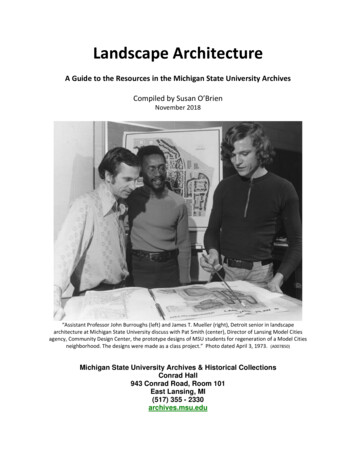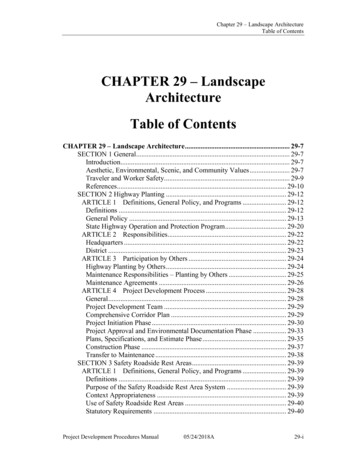
Transcription
Chapter 29 – Landscape ArchitectureTable of ContentsCHAPTER 29 – LandscapeArchitectureTable of ContentsCHAPTER 29 – Landscape Architecture. 29-7SECTION 1 General. 29-7Introduction. 29-7Aesthetic, Environmental, Scenic, and Community Values. 29-7Traveler and Worker Safety. 29-9References. 29-10SECTION 2 Highway Planting . 29-12ARTICLE 1 Definitions, General Policy, and Programs . 29-12Definitions . 29-12General Policy . 29-13State Highway Operation and Protection Program. 29-20ARTICLE 2 Responsibilities. 29-22Headquarters . 29-22District . 29-23ARTICLE 3 Participation by Others . 29-24Highway Planting by Others. 29-24Maintenance Responsibilities – Planting by Others . 29-25Maintenance Agreements . 29-26ARTICLE 4 Project Development Process . 29-28General. 29-28Project Development Team . 29-29Comprehensive Corridor Plan . 29-29Project Initiation Phase . 29-30Project Approval and Environmental Documentation Phase . 29-33Plans, Specifications, and Estimate Phase. 29-35Construction Phase . 29-37Transfer to Maintenance . 29-38SECTION 3 Safety Roadside Rest Areas. 29-39ARTICLE 1 Definitions, General Policy, and Programs . 29-39Definitions . 29-39Purpose of the Safety Roadside Rest Area System . 29-39Context Appropriateness . 29-39Use of Safety Roadside Rest Areas . 29-40Statutory Requirements . 29-40Project Development Procedures Manual05/24/2018A29-i
Part 3 – Specific Project Development ProceduresState and Federal Accessibility Requirements . 29-42State Energy and Environmental Design Requirements. 29-42Safety Roadside Rest Area Master Plan . 29-43Safety Roadside Rest Area Rehabilitation Program. 29-44New Safety Roadside Rest Areas Program . 29-44Wayside Stop Demonstration Program . 29-44ARTICLE 2 Responsibilities. 29-47Headquarters Landscape Architecture Program . 29-47Headquarters Division of Engineering Services-Structure Design,Office of Transportation Architecture . 29-49District . 29-50ARTICLE 3 Project Development Process . 29-51General. 29-51Safety Roadside Rest Area Partnership Projects . 29-52Site Requirements. 29-53Site and Architectural Analysis . 29-53Leadership in Energy and Environmental Design andCalifornia Green Building Standards Code Analysis . 29-54Stakeholder Involvement . 29-54Design Charrette Process . 29-54Project Initiation Phase . 29-55Project Approval and Environmental Documentation Phase . 29-56Plans, Specifications, and Estimate Phase. 29-57ARTICLE 4 Closure. 29-58Emergency or Intermittent Closure . 29-58Permanent Closure. 29-59Temporary Closure for Construction . 29-60ARTICLE 5 References . 29-61SECTION 4 Vista Points. 29-62ARTICLE 1 General Policy . 29-62Purpose of Vista Points. 29-62General Considerations. 29-62Preservation of Views. 29-62Americans with Disabilities Act of 1990 Compliance . 29-63Signage Requirements . 29-63Vista Point Inventory. 29-63ARTICLE 2 Project Development Process . 29-64ARTICLE 3 References . 29-64SECTION 5 Park-and-Ride Facilities . 29-65ARTICLE 1 General Policy . 29-65Purpose of the Park-and-Ride System . 29-65Use of Park-and-Ride Lots . 29-65Statutory Requirements . 29-65State and Federal Accessibility Requirements . 29-66Park-and-Ride Lease Program . 29-67ARTICLE 2 References . 29-6729-ii05/24/2018AProject Development Procedures Manual
Chapter 29 – Landscape ArchitectureTable of ContentsSECTION 6 Aesthetics. 29-68General. 29-68Aesthetic Considerations . 29-68SECTION 7 Blue Star Memorial Highways . 29-70ARTICLE 1 Purpose and General Policy. 29-70Purpose of Blue Star Memorial Highways . 29-70General Policy . 29-70ARTICLE 2 Responsibilities. 29-70Headquarters . 29-70District . 29-70Permittee . 29-71ARTICLE 3 Guidelines. 29-71Location of Markers . 29-71Maintenance. 29-72Dedication Ceremony . 29-72SECTION 8 Scenic Highways and Byways. 29-73ARTICLE 1 General Policy and Program. 29-73General. 29-73Corridor Protection Program . 29-73ARTICLE 2 Designation and Design Considerations. 29-74The Official Designation Process . 29-74Adding State Highways to the Scenic Highway System . 29-75County Roads as Part of the Scenic Highway System . 29-75Scenic Highway Identification . 29-75Scenic Highway Program Funding . 29-75Widening a Scenic Highway . 29-75Official Designation Does not Preclude Development. 29-76Revoking a Scenic Highway Designation . 29-76Scenic Highway Designation Benefits . 29-76SECTION 9 Transportation Art . 29-78ARTICLE 1 General Procedure . 29-78Statutory Authority . 29-79Intellectual Property Rights - Copyright Ownership ofTransportation Art . 29-79Artist Disclaimer Statement. 29-79Sponsor Recognition. 29-79Sponsor Recognition Disclaimer Statement . 29-80Placement. 29-80Transportation Art Requirements . 29-80ARTICLE 2 Responsibilities. 29-82Administrative Responsibilities. 29-82Financial Responsibilities. 29-84Maintenance Responsibilities . 29-84ARTICLE 3 Project Development Process . 29-85Processing Transportation Art Proposals. 29-85Preliminary Proposal Review . 29-85Project Development Procedures Manual05/24/2018A29-iii
Part 3 – Specific Project Development ProceduresPublic Review and Public Agency Resolution . 29-87Final Proposal Review. 29-88District Director Review. 29-88Encroachment Permit Process . 29-88After Construction . 29-88SECTION 10 Community Identification. 29-89ARTICLE 1 General Procedure . 29-89Community Identification Requirements . 29-90ARTICLE 2 Responsibilities. 29-92Administrative Responsibilities. 29-92Financial Responsibilities. 29-93Maintenance Responsibilities . 29-94ARTICLE 3 Project Development Process . 29-95Processing Community Identification Proposals. 29-95Preliminary Proposal Review . 29-96Public Review and Public Agency Resolution . 29-97Final Proposal Review. 29-98District Director Review. 29-98Encroachment Permit Process . 29-98After Construction . 29-99SECTION 11 Gateway Monuments. 29-100ARTICLE 1 General Procedure . 29-100Statutory Authority . 29-101Placement. 29-101Gateway Monument Requirements . 29-101ARTICLE 2 Responsibilities. 29-103Administrative Responsibilities. 29-103Financial Responsibilities . 29-105Maintenance Responsibilities . 29-105ARTICLE 3 Project Development Process . 29-106Processing Gateway Monument Proposals. 29-106Preliminary Proposal Review . 29-107Public Review and Public Agency Resolution . 29-108Final Proposal Review. 29-109District Director Review. 29-109Encroachment Permit Process . 29-109After Construction . 29-10929-iv05/24/2018AProject Development Procedures Manual
Chapter 29 – Landscape ArchitectureTable of ContentsTable of FiguresFigure 29-1 Determining Local Participation in Highway Planting. 29-27Figure 29-2 Responsibilities for Highway Planting Funded by Others. 29-28Figure 29-3 Water Conservation Categories and Required Actions. 29-37Figure 29-4 Transportation Art, Community Identification, andGateway Monuments . 29-78Figure 29-5 Transportation Art, Community Identification, andGateway Monuments . 29-89Figure 29-6 Transportation Art, Community Identification, andGateway Monuments . 29-100Project Development Procedures Manual05/24/2018A29-v
Part 3 – Specific Project Development Procedures29-vi05/24/2018AProject Development Procedures Manual
Chapter 29 – Landscape ArchitectureSection 1 – GeneralCHAPTER 29 – Landscape ArchitectureSECTION 1 GeneralIntroductionAs the primary program responsible for the design of the highway roadside, theHeadquarters Landscape Architecture Program (LAP) provides expertise in theplanning, design, construction, maintenance, and operation of transportation systemimprovements that: balance mobility, safety, maintainability, and economic needs with adjacentland use and aesthetic, environmental, scenic, and community values.improve motorized and nonmotorized safety through the design of contextsensitive roadways and transit, bicycle, and pedestrian facilities.improve traveler and worker safety by providing design solutions that reducethe frequency and duration of maintenance worker exposure to traffic.improve traveler safety through the design of safety roadside rest areas andmanagement of safety roadside rest area system needs.Aesthetic, Environmental, Scenic, and Community ValuesTo make projects successful and to provide the best overall public benefit, the projectdevelopment process includes evaluating and addressing impacts to aesthetic,environmental, scenic, and community values in balance with transportation goals.The profession of landscape architecture utilizes site planning and design techniquesthat work in harmony with both constructed and natural environments. Landscapearchitects offer the project development team (PDT) a broad range of skills to identifyinnovative design solutions that address often competing requirements.Aesthetic ValuesLandscape architects provide expertise to protect and improve scenic views bothtowards and away from transportation improvements. Community and Caltransaesthetic values may be incorporated into transportation projects by providingaesthetic reviews, visual impact assessments, comprehensive corridor plans, andaesthetic design guidance.Project Development Procedures Manual05/24/2018A29-7
Part 3 – Specific Project Development ProceduresEnvironmental ValuesLandscape architects provide design expertise to integrate transportation facilitieswith the physical, natural, and constructed environment, including habitatconservation and restoration; conservation of agricultural lands; water conservationthrough the use of drought tolerant plants and inert materials; the design of irrigationsystems using non-potable water sources; and stormwater pollution preventionthrough erosion control techniques.Landscape architects also provide design expertise in the selection and placement ofplanting provided to replace existing native or non-native planting removed byroadway construction activities. This work includes restoration of native landscapeareas, required mitigation planting, highway planting revegetation, and replacementhighway planting. These projects help mitigate the environmental impact of roadwayconstruction projects.Visual QualityAs part of the environmental planning process, landscape architects assess potentialadverse visual impacts of transportation projects adjacent to communities or naturalscenic resources. Landscape architects work with permitting agencies, localcommunities, and the PDT to consider avoidance mitigation measures. Landscapearchitects perform scenic resource evaluations and visual impact assessments, andthey provide design expertise to protect and preserve scenic resources. For moreinformation on preliminary assessments, scenic resource evaluations, and visualimpact assessments, see Chapter 8 – Overview of Project Development.Community ValuesLandscape architects assist in integrating transportation needs with existingcommunity goals and values by providing expertise in comprehensive corridorplanning, urban design, historic preservation, and community involvement. They alsoassist in facilitating timely project delivery and building community consensus byimplementing principles of community involvement and context-sensitive design,including: 29-8harmonizing the roadway with existing topography and land uses.preserving and enhancing community character.meeting the needs of nonmotorized travelers.preserving historic resources such as historic landscapes.05/24/2018AProject Development Procedures Manual
Chapter 29 – Landscape ArchitectureSection 1 – General supporting the incorporation of transportation art, gateway monuments, andcommunity identification.Traveler and Worker SafetyLandscape architects contribute to the safety of the traveling public and highwayworkers through roadside design techniques that minimize or eliminate workerexposure to traffic. These design techniques can be grouped into three categories:safe facility location, recurrent activity elimination, and safe maintenance access.Safe Facility LocationThese improvements enhance safety by placing or relocating facilities that requirerecurrent maintenance activities to protected areas or to areas outside the clearrecovery zone. Typical examples include locating, relocating, or clustering facilitiessuch as irrigation controllers, backflow preventers, remote control valves, rampmeters, changeable message sign controls, and cabinets to areas adjacent to the rightof-way fence or to protected areas. See the Highway Design Manual (HDM), Topic706, for more information.Recurrent Activity EliminationThese improvements enhance safety by reducing or eliminating recurrentmaintenance activities such as frequent pruning, graffiti removal, irrigation systemrepair, herbicide application, and weed control. Typical examples include thefollowing: Removing plant material that encroaches upon sight distancesPlanting shrubs or vines or using textures on noise barriersAutomating irrigation systemsProviding vegetation control treatment beneath guardrails and signsPaving slopes beneath bridge structuresPaving narrow areasProviding contrasting surface treatment (paving) beyond the gore areapavementPlacing rock or other inert mulch materialsRemoving signs that are no longer requiredProject Development Procedures Manual05/24/2018A29-9
Part 3 – Specific Project Development ProceduresSafe Maintenance AccessThese improvements enhance safety by providing maintenance workers with safeaccess to roadway and roadside facilities requiring regular maintenance and includeproviding stairs on steep slopes, maintenance access roads, maintenance access gates,and maintenance vehicle pullouts.ReferencesThe Highway Design Manual contains design standards and guidelines concerningthe planting and conservation of existing vegetation, the development of highwayplanting projects, and the incorporation of scenic values in highway design. Themanual also includes design standards and guidelines for safety roadside rest areasand vista points.The Storm Water Quality Handbooks: Project Planning and Design Guide providesdesign guidance for selecting and designing stormwater quality best managementpractices (BMPs) during the planning and design phase of a project.Chapter 27 of the Standard Environmental Reference (SER) provides guidelines forconducting scenic resource evaluations and for performing visual impact assessmentsduring the project development process.Chapter 28 of the Standard Environmental Reference provides guidelines fordeterminations of historic property eligibility and identification of historic landscapesduring the project development process.The Encroachment Permits Manual contains procedures and guidelines for permittingwork by others, including planting design, transportation art, communityidentification, and gateway monuments.The Construction Manual describes administration and oversight of projects.The Maintenance Manual contains instructions about the maintenance of roadsidevegetation and other roadside facilities.The Landscape Architecture PS&E Guide provides guidelines for the preparation ofhighway planting and irrigation plans, specifications, and estimate (PS&E).The Plans Preparation Manual and the CADD Users Manual provide guidelines forthe preparation of highway planting and irrigation plans.29-1005/24/2018AProject Development Procedures Manual
Chapter 29 – Landscape ArchitectureSection 1 – GeneralCaltrans Best Practices Public Participation Reference provides the planning processto seek out and consider the needs of all stakeholders in order to maximize thepotential and benefit of public involvement and to adequately respond to and meet therequirements of State and federal legislation and mandates and Caltrans’ policies andgoals.The Main Street, California booklet emphasizes Caltrans’ commitment to andprovides guidance on the safe, context-appropriate design of State highways thatfunction as community main streets.The Headquarters Division of Project Management Project CommunicationHandbook helps the project team identify internal and external stakeholders andimproves communication among all parties.Design Information Bulletin 82 – Pedestrian Accessibility Guidelines for HighwayProjects, provides design guidance for pedestrian accessibility for highway projects.The Federal Highway Administration’s (FHWA) Flexibility in Highway Designprovides guidance for creating transportation facilities that conserve and enhanceenvironmental, scenic and community resources.The FHWA Executive Memorandum issued April 26, 1994, Environmentally andEconomically Beneficial Practices on Federal Landscaped Grounds, providesguidance on using native plant material and integrated pest management techniques toconserve water and reduce pollution.The FHWA Executive Memorandum issued August 18, 1999, GuidanceImplementing Executive Order 13112 Invasive Species, provides guidance onimplementing Executive Order 13112 signed by President Clinton on February 3,1999, which strives to control the introduction and spread of invasive species andminimize their impact on economic, ecological, and human health.Project Development Procedures Manual05/24/2018A29-11
Part 3 – Specific Project Development ProceduresSECTION 2 Highway PlantingARTICLE 1Definitions, General Policy, andProgramsDefinitionsEstablish existing planting – the period of time that allows newly installed plantmaterial to reach a state of maturity that requires minimal additional maintenance.Establish existing planting work is accomplished via a separate contract that beginsjust after the completion of a planting and irrigation contract. The majority of thework performed during an establish existing planting project is identical to plantestablishment; however, an establish existing planting project includes additionalactivities at the start of the project, including checking plants for deficiencies,checking and testing irrigation facilities, and repairing identified deficiencies.Highway planting – the term includes new highway planting, replacement highwayplanting, roadside rehabilitation, highway planting revegetation, required mitigationplanting, and irrigation system upgrade work. Highway planting addresses safetyrequirements, provides compliance with environmental commitments, and assists inthe visual integration of the transportation facility within the existing environs.Irrigation system upgrade – the conversion of a manually-operated irrigation systemto an automatic or remote irrigation control system (RICS), replacement of obsoleteirrigation components, conversion of a potable water irrigation system to non-potablewater, and worker safety improvements.Landscaped freeway – the planted section of freeway that meets the criteriaestablished by the California Outdoor Advertising Act. This designation is used inthe control and regulation of outdoor advertising displays.Plant establishment – the period of time that allows newly installed plant material toreach a state of maturity necessary to require minimal future maintenance. FHWAregulations require a plant establishment period of sufficient length to ensure thesurvival of new plant material for all projects that include highway planting. Theplant establishment period typically includes replacement of dead or damaged plantmaterial; weed, rodent, and pest control; irrigation operation and repair; and otheractivities required to ensure the long-term survival of plant material.29-1205/24/2018AProject Development Procedures Manual
Chapter 29 – Landscape ArchitectureSection 2 – Highway PlantingGeneral P
The profession of landscape architecture utilizes site planning and design techniques that work in harmony with both constructed and natural environments. Landscape architects offer the project d


